#uselesslgbtfacts
Text

A protester in a demonstration in favour of the rights of homosexual people. Year 1979 in Barcelona, Catalonia. Photo by Pilar Aymerich (source).
Did you notice the sticker?
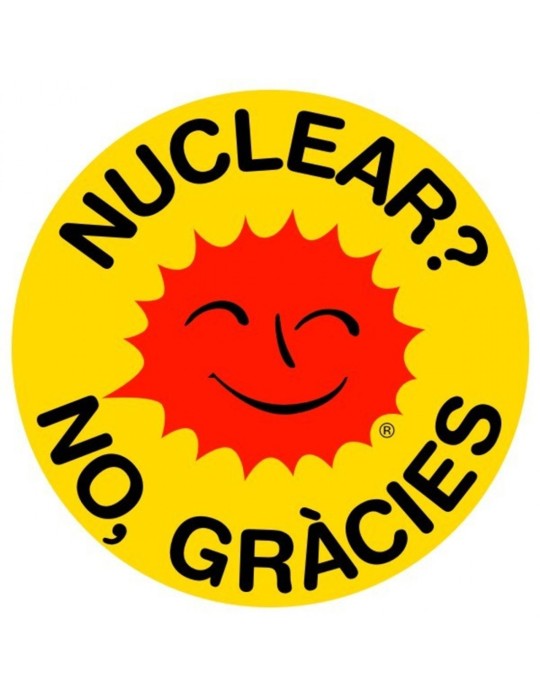
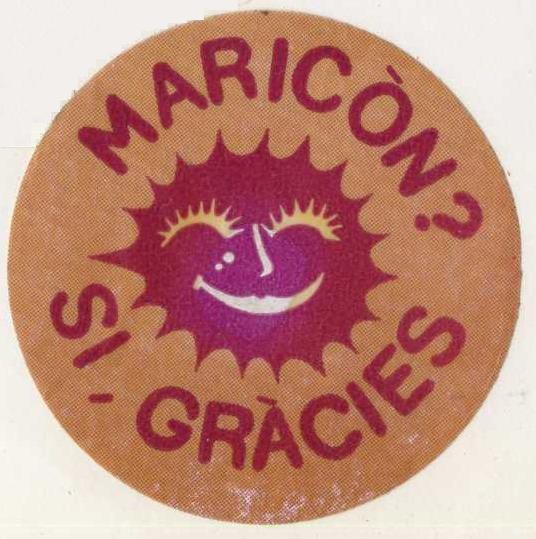
In the late 1970s, one of the most popular slogans in the Gay and Lesbian movement in Catalonia was "Maricon? Sí, gràcies" (Catalan language for "Faggot? Yes, thanks") in the shape of the famous "Nuclear? No, thanks" sign.
#uselesslgbtfacts#història#catalunya#pilar aymerich#coses de la terra#1970s#history#queer#queer history#gay#gay history#lgbt#lgbt history#europe#photojournalism#pride#lgbtq history#lgbtq#counterculture
3K notes
·
View notes
Photo




Annemarie Schwarzenbach was a Swiss writer, photographer, journalist and traveller. She dressed androgynously from an early age on and was often mistaken for a young man. One of her friends, Marianne Breslauer described her as “Neither a woman nor a man, but an angel, an archangel.”
Schwarzenbach has written multiple books and has documented the rise of fascism in Europe and her travels to various European countries with her photographs.
7K notes
·
View notes
Photo

The earliest mention of homosexuality and homosexual relations on Slovene territory comes from castle Hrastovec {pictured above}, dating from the year 1749, when Peter Vombek (also Vambek, Bombek) (60 y. o.) and Anton Gabrovec (55 y. o.) – both from Vinička vas – had drunk sex one night in May, to which the latter admitted after being prodded about it by his landlady (replying with “old dogs are people too ...”). She heard unusual movement taking place in his room that night, as well as someone saying: “one ass is not much different than another” / “one ass is worth as much as another.”
The punishment they received was especially harsh: they were decapitated by sword, their bodies and heads were then burned at the stake and the remaining ashes were scattered into the air. The judge initially suggested a milder sentence due to their inebriated state (= expulsion from the Styrian lands and 10 years of forced labour), but his plea to Maria Theresa was denied and she demanded they be sentenced to death in the manner described above (which became the standard punishment for “sodomy” when her Constitutio Criminalis Theresiana came into effect in 1768, some twenty years later).
The slightly differing accounts of the events which I used in making this post can be found here and here.
131 notes
·
View notes
Text
Hi everyone!
Pride month commemorates the Stonewall riots in the US. My dashboard is full of posts about US LGBT icons, US LGBT events and so on. But what about the rest of the world?
This is why some admins and I have decided to make another “challenge” in the next couple weeks, where we post about LGBT facts from our countries. The struggle for acceptance is by far not unique to the US, and there are many stories to be told about LGBT history in other countries.
Here are some suggestions about what you can post:
Pride parades in your country (photos, gifs, videos...)
Important historical and contemporary LGBT people from your country
Movies or art about LGBT people, or LGBT history in your country
Important events for the LGBT community (legal/political decisions, riots, parades etc.)
LGBT history of your country
LGBT language (how to express gender neutrality, vocabulary lists about sexual orientations, genders etc)
LGBT groups in your country, where to meet LGBT people,
Of course, people that aren’t part of ucf are also happy to join, it would be great if you can submit posts, tag admins of the corresponding country, or just simply tag the posts with #uselesslgbtfacts.
Happy pride everyone!
136 notes
·
View notes
Text
Lesbian, gay, bisexual and transgender (LGBT) rights in Malta have evolved significantly over the course of the last decades. Throughout the late-20th century, the rights of the LGBT community received more awareness. Malta has been recognized for providing a high degree of liberty to its LGBT citizens. In October 2015, the European region of the International Lesbian, Gay, Bisexual, Trans and Intersex Association (ILGA-Europe) ranked Malta 1st in terms of LGBT rights out of 49 observed European countries. Malta is one of the only few countries in the world to have made LGBT rights equal at a constitutional level. In 2016, Malta became the first country in the European Union to ban conversion therapy.
125 notes
·
View notes
Photo
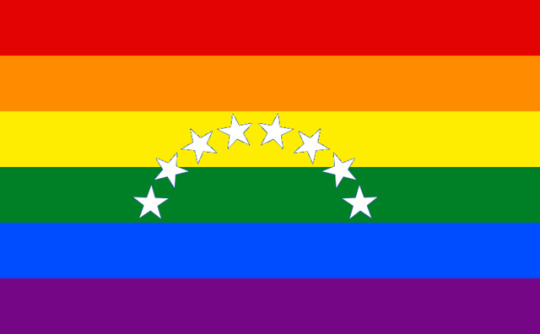
The LGBTA+ Community in Venezuela
Despite unfriendly legislation, Venezuela has a thriving LGBTA+ community, and the government annually declares Pride Day in June. However, same-sex marriage and unions are not legally recognized, as well as legal gender change (however, trans individuals can request ID changes to match their preferred gender and name). Sequential adoption for same-sex couples is legal, as well as IVF for lesbian couples, but same-sex couples cannot adopt a child as a couple.
Public opinion towards LGBTA+ individuals is mixed. As of late 2013, only 20% of Venezuelans believed that same-sex marriage should be legal, but 51% believed that homosexuality should be accepted by society. Venezuela ranks 45th on the Gay Happiness Index (GHI).
#uselesslgbtfacts#lgbt pride#queer pride#pride month#venezuela#this time on the right blog :')#tomorrow is important figures
47 notes
·
View notes
Text
Florenci Pla Meseguer "La Pastora", intersex antifascist hero
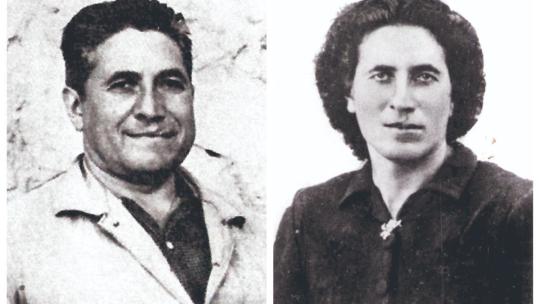
One of the most famous maquis (guerrilla fighters against Franco's dictatorship) is Florenci Pla Maseguer.
(thank you @neonbutchery for the suggestion)
He was born in a farmhouse in Vallibona, in the rural mountains in north of the Valencian Country, in 1917. His body did not fit the categories of either male nor female, so his family were left with the choice of what sex to register him as. His parents decided to register him as female so that he could avoid the mandatory military service.
He grew up in the farmhouse being a shepherd, and never went to school as was usual at the time for the rural working class. When he reached puberty, he developed male secondary sex characteristics.
When the fascists did a coup d'état in 1936, sparking the Spanish Civil War, he wanted offered himself as a volunteer to fight in the republican (=antifascist) army, and he thought that this way he would get officially registered as a man, but couldn't.
He kept dressing as a woman until he was 30 years old, but always felt a man. In his words (originally in Catalan in this interview in El Temps from 1988):
Interviewer: What did you think of your sexual condition? Did it cause you any worries?
Florenci: Problems...? Mainly because of the beard. They said I was half man and half woman, but I never felt a woman. I still remember the first time I dreamed I had an affair with a woman, when I was 13 (...)
I: Have you always felt a man?
F: Always, and I have always liked men's jobs and being registered as a man. In fact, when I walked the flock I carried a sarró [=a kind of bag], like men, and not a basket like women.
He kept wearing women's clothes until he was 30, when he joined the maquis. By then, it was 1947; the fascists had won the war in 1939 and, as a result, Spain and its occupied territories were ruled by Franco's fascist dictatorship, which persecuted the political dissidence, the national minorities (such as Catalans-Valencians) and their languages, and everyone who didn't fit the strict normative and nationalcatholic morale, prominently LGBTQI+ people and women who didn't limit themselves to the roles that the patriarchal society considered fit. The maquis were the armed resistance.
I: How did you change the flock for the maquis?
F: Since I lived in the mountains, I had sometimes talked to them. On a snowy night, three maquis took refuge in a house that was only inhabited in summer -El Cabanil- but one of them ran away -one who was from Morella- and everywhere he went, he spread the word, he snitched it. And the Civil Guard [=the regime's military police] followed their clue until they found them and burned the house down, because they were resisting. The next morning, they arrested El Cabanil's owner and I got nervous because I worked for him, and I decided to escape out of fear of being killed.
I: Was it because of the fear of reprisals or for the humiliations to which the Civil Guard put you through?
F: Yes, that determined it, too. That was on the morning of the same day they burned down El Cabanil, and it was "teniente Mangas" [="lieutenant" Mangas, which he says in Spanish], six guards and two militiamen, one from Torremiró and the other one from Herbesset.
I: And what did they do to you exactly?
F: They were curious to know how could a shepherd girl be half man and half woman. I had sold thrushes to the militiamen, and they told the Civil Guard about my anomaly. Teniente Mangas ignored all rules and made me take off my clothes, until their curiosity was fulfilled. And when they were done, they said "bueno, a hacer bondad" ["well, behave" in Spanish, as a way to say goodbye]. And I felt so much rage, so much helplessness.
(...)
I joined [the guerrilla] and I dressed as a man. There, I was a man like any other.
From then on, he lived as a man and named himself Florenci, though he was known with other nicknames like "Durruti" (after the famous anarchist leader) and, most famously "La Pastora" (the shepherd).
He ended up living in Andorra, but a journalist for the Spanish tabloid El Caso published about him, attributing to him the crimes committed by other maquis, even ones that he had never met. For this reason, La Pastora became famous in all of Spain and the police intensified the search. The Andorran police turned him in to the Spanish police in 1960, accusing him of robbery, banditry and terrorism. He was judged twice for the same crimes: a tribunal sentenced him to 40 years of prison and the other one sentenced him to death and later changed it to 30 years of prison.
He spent 17 years in prison. First, in a women's prison where the women (and him) had to wear very tight miniskirts. He was later moved to a men's jail, where the case was further investigated. The detective saw that there was no proof and that the story didn't match up, so it was impossible that Florenci had committed these crimes. He was freed with a pardon in 1977 and the detective officially registered him as a man.
Despite the slander published by the press, when he came back to his hometown Vallibona, everyone came down to the village from their farmhouses to greet him. He died in 2004, at 86 years old.
Nowadays, Florenci "La Pastora" is by far one of the most famous maquis, if not the single most famous one. He is talked about in songs, books and documentaries, and has become an icon of the antifascist resistance.
#història#país valencià#florenci pla meseguer#la pastora#uselesslgbtfacts#maquis#history#intersex#intersex history#queer history#queer#lgbt history#lgbtq#lgbtq history#antifascist#working class history#antifascism#guerrilla#20th century history
190 notes
·
View notes
Text
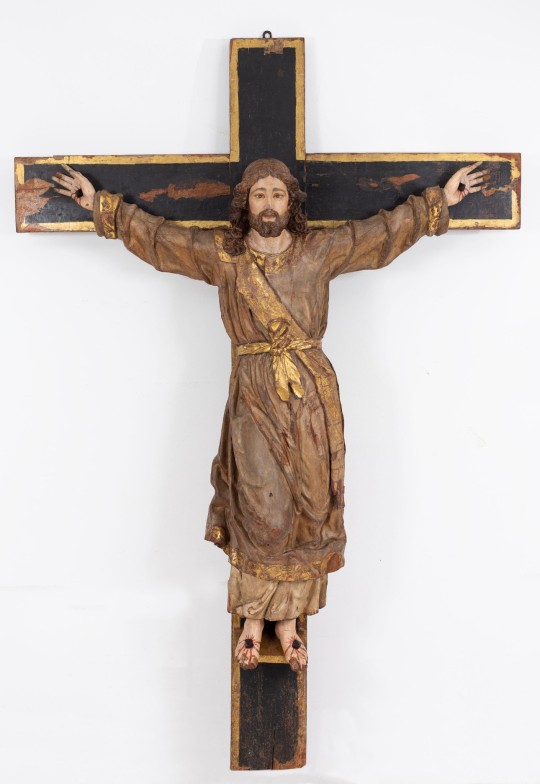
When Catalonia's National Art Museum (MNAC) acquired this piece, they thought it represented Jesus Christ on the cross. On a closer study, they realised it represents a woman: Saint Wilgefortis (Santa Lliberada in Catalan, which means "Saint Liberated").
This wooden sculpture was made by an artist called Andreu Sala around the year 1689 for the church of El Carme in Barcelona, Catalonia. But why does a female saint have a beard? This is not a shock to anyone familiar with this saint's story.
According to the legends, Wilgerfortis was the daughter of a pagan king of Portugal. She converted to Christianity in secret and made a vow of chastity. Her father gave her hand in marriage to a pagan or Moorish king, but she refused to marry anyone. To avoid marriage, she prayed to God to disfigure her to make men find her ugly. God answered her prayers and blessed her by making her grow a beard. The marriage was broken and that made her father angry. He accused Wilgerfortis of witchcraft and had her crucified, like Christ had been.
There are different hypothesis about the origin of this legend:
Some say it might be related to ancient intersex divinities, such as the Ancient Greek Hermaphroditus.
Others say it might have its origin in a side-effect of malnourishment that many nuns had. In convents, it was very common to fast (=not eat for long periods of time for religious reasons), so many nuns had hormonal imbalances that can result in growing facial hair.
The most widespread hypothesis seems to be that Saint Wilgerfortis and similar legends were created to re-interpret the Christs in Majesty that culturally didn't seem male anymore. Because of Byzantine influence, in the Romanesque period (11th-13th centuries), sometimes Christ on the Cross was represented wearing a long tunic tied at the waist and looking calm. After that period, Christ on the Cross was always represented half naked and suffering. They are so different that they look like different saints and the long dress fitted at the waist was associated with women at the time, so people who saw the old representations of Christ would assume it was a woman with a beard, and came up with legends to explain the beard.

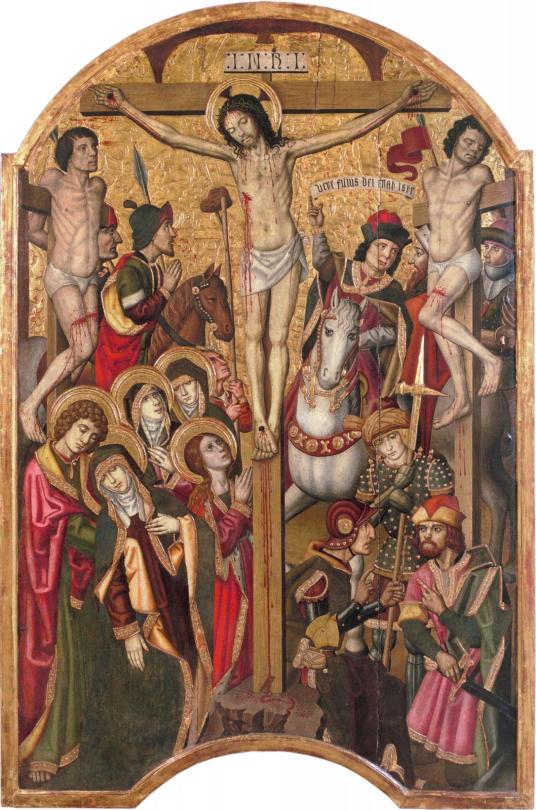
Here you can compare the two ways of representing Christ. On the left, the statue called Majestat Batlló, made in the 1100s in la Garrotxa (Catalonia) in Romanesque style. On the right, the Calvari painting made around 1470 in Granollers (Catalonia). Both of them are kept in MNAC.
There are some other saints with very similar stories to Saint Wilgefortis, like Saint Múnia of Barcelona.
Now you might be wondering, how do we know this statue represents Saint Wilgefortis and not Christ? First of all, this statue is from the Baroque period, where Christ was never represented wearing a long tunic and hadn't been for centuries. Culturally, it would not make any sense for a Catalan artist in the 1600s to represent Christ or any normative man wearing what by then was a woman's dress. Secondly, if you look at the statue from the side, you can see that she has some boobs. And lastly, when the statue was restored, they found a textile fragment at the bottom of the tunic, which was a stitching work made from lace. Traditionally, lace has been a type of decoration used in women’s clothing.
So there is no doubt that this statue, like others that can be found all around Europe, represents Saint Wilgefortis. The woman who was blessed with a beard, and who we call Saint Liberated because her beard liberated her.
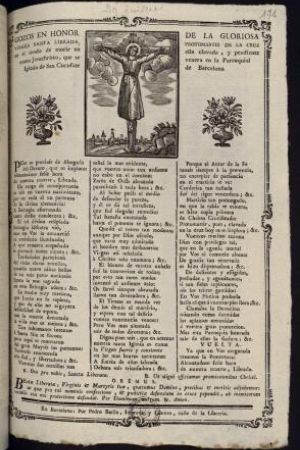

Couplets in honour of Saint Wilgefortis for the church Sant Cugat del Rec in Barcelona, Catalonia. 18th century. Source: Mediateques Montpellier. Here, the images represent her without a beard, but the poem explains her story.
Traditionally, Saint Wilgefortis has been patron saint of agriculture, travellers, children who were stunted or had difficulty walking, skin diseases, pets, laundresses, and the agony of the dying. In more recent times, two more were added: Saint Wilgefortis is the patron saint of transgender people and has been claimed as a lesbian martyr.
Source: Museu Nacional d'Art de Catalunya.
#arts#escultura#uselesslgbtfacts#mnac#baroque#saint wilgefortis#folk saint#trans#transgender#intersex#art history#trans history#museums#museum#history#història#catholiscism#catholic#eating disorder mention#religion
96 notes
·
View notes
Text
I think it’s time to address the Mallorca lesbians comment, isn’t it?
If you’re not from a Catalan-speaking country, you won’t have heard about this, but people in Mallorca (Balearic Islands) are mad, and rightfully so.
This week was the beginning of Palma Pride Week, an event (named in English, of course) that is pretty much the textbook definition of the capitalist party Pride event. It’s held in Palma, which is Mallorca’s capital city, and organized by the association Ella Global Community.
The inauguration speech was given by Kristin Hansen (president of Ella Global Community), who has been living in the island for 15 years but was unable to give the speech in the island’s language (Catalan), because she has never bothered to learn it.
In the speech (in Spanish), she said that Pride is a good opportunity not only for LGBTI people to attend to it, but also “people from the countryside who have never seen a lesbian. They will come and say, ‘Look! A lesbian is just like any other person’. It’s important because you go 15 kilometres inside the island and the mentality changes.”
Of course, Mallorcan people have felt deeply insulted with this ignorant and prejudiced statement.
Legislation and the social normalization of LGBTQIA+ rights has been way more advanced in Mallorca than in Germany (where Kristin Hansen is originary from) for decades, and in the island there has been a grassroots LGBTQIA+ movement for longer than she has lived here. And this movement was born from the Mallorcan people, in all the island, and not from rich tourists nor only in the capital. The organization Ben Amics has been working since 1994. Same-sex marriage has been legal in the Balearic Islands since 2001, while in Germany it was only legalized in 2017.
The matter is easy: everyone wants to live in paradise, so many people from Northern Europe move to beautiful Mallorca or other sunny Mediterranean places; but nobody wants to live with its people. Hansen has showed absolute ignorance and disrespect towards Mallorcan people, accusing them falsely and acting like we need them Germans or Central/Northern Europeans to save us and bring us to progress. Well, that’s false. Mallorcans are way ahead of Germany when it comes to LGBTQIA+ rights, and they don’t go around saying “those backwards people from Hünstetten and Waltershausen will see a lesbian for the first time thanks to us!”
There are lesbians everywhere. And there are gay, trans, bi, ace, aro, intersex, questioning and queer people everywhere. But there are also self-centered and ignorant people everywhere. The Palma City Hall should not have left the organization of an event like this one to someone with this prejudiced mindset.
Mallorcan organizations are asking Ella Global Community to apologize for her words and to change the objectives of Palma Pride Week. Because, right now, this is how Kristen Hansen described the event: "We will position Mallorca as an LGBTQI destination. It's a business opportunity: LGBT tourism spends much more money than the average tourist, about 180,000 million dollars, and it's an interesting, learned, and pleasant tourism."
Exactly one day after the Federació d'Entitats Veïnals de Palma (Federation of Neighbour Associations of Palma) met with the city hall to demand measures against the massification of tourism and the gentrification it brings, Hansen said that they expect Pride Week will bring between 7,000 and 10,000 tourists to the Sa Feixina neighborhood in one week. She added "Then these people will come here and buy apartments. We make a living from tourism, from real estate, from ships", as if it were a good thing.
Palma Pride Week's programme is centered on conferences about entrepreneurship, yoga, and "soul worshipping" to make the collective visible and to make Palma "the cosmopolitan city we want it to become". No, Palma is a city where local people can barely afford to continue to live in, where massive tourism doesn't let them live their lives.
The interests shown by Ella Global Community and its wealthy members are aligned with the interests of rich owners who are making life hell for the inhabitants of the island. They don't represent the interests of Mallorcan LGBTQIA+ people. In their objective of creating a paradise for rich LGBT tourists, they are kicking out local people, including local LGBTQIA+ people.
Ben Amics organizes a Pride month too, this year titled "30 years of fight: rights and resilience", with a programme that actually aims to fight, raise awareness and discuss gender and sexual diversity and dissidence. Created by Mallorcan LGBTQIA+ people answering to their needs. If you are going to support a Pride event in Mallorca, be it this one.
#actualitat#palma pride week#mallorca#illes balears#pride#pride month#lgbtq#majorca#southern europe#capitalism#rainbow capitalism#tourism#touristification#coses de la terra#lgbt#lesbian#gentrification#queer#ella global community#uselesslgbtfacts
798 notes
·
View notes
Video
They knew it since the moment they met. It was in Barcelona. Ramon had moved there after finishing the mandatory military service and he saw Jordi for the first time in a restaurant, having dinner. “I took him home on the first date because I saw he would be a good person”, explains Jordi.
They fell in love during Franco’s dictatorship, when being homosexual was persecuted. They always had to take care with what they did and didn’t do in order to avoid being pointed at. Now, 56 years later, Jordi and Ramon think of a whole life together.
They went often to Horta de Sant Joan, Ramon’s town. There, they slept together in a double bed at his parents’ house. The family always respected their decisions, though they never openly talked about their relation with them.
I’ve added subtitles to this story posted by 3/24. It wasn’t so long ago that the situation was this.
#uselesslgbtfacts#història#lgbt#lgbtq#franquisme#gay#lgbt history#mlm#gay elders#gay couple#lgbtqia#lgbt+#queer elders
723 notes
·
View notes
Note
the guy I'm dating recently discovered he really loves it when I recite things in his ear. do you have any gay love poetry in Catalan for me to try with him?
Lluís Llach!!! He's a singer-songwriter, but I don't doubt at all to also call him a poet. His lyrics are absolutely beautiful. It's no wonder that he's the most iconic Catalan singer of all times.
My favourite love songs by him are "Núvol blanc" (seriously this song is so beautiful and gentle 🥹), "Onades" and "Al teatre". His most famous love song is "Amor particular", and also "Criatura dolcíssima" but this one is a musical adaptation of the poem by Joan Fuster so maybe doesn't quite count but it was written as music by Lluís Llach and is beautiful. Also "Som tu i jo", "Alè", "Només per a tu", "Un no sé què", "Tendresa", "Torna aviat", "Véns", and "Veritat i mentida".
I doubted about including "Que tinguem sort" because he's dubious in the song about being together or potentially being left (each stanza is "if you say goodbye...", "if you say you want me...", and "If you come with me..." but it goes to more certainty) but wishing the best for the other person in any case. It's one of Lluís Llach's most famous songs and I couldn't not include it in the post.
You can find all the lyrics on Google. I don't know if someone has posted English translations though.
I must say, since Catalan is gendered differently than English, talking about someone else is often gender-neutral so most of his songs are gender-neutral (only in "Veritat i mentida" we can see explicitly it's about a man because of the use of adjectives). But Lluís Llach is gay so even if we can't tell the gender of the loved person by the lyrics, that counts.
If you're looking for written poems, there's very famous lesbian poetesses but historically I don't know gay poets who have written about it. For contemporary poetry, you can check the entries to the festival Qlit (Festival de Literatura Queer) organized by the Associació d'Escriptors en Llengua Catalana or the book Amors sense casa. Poesia LGBTQ catalana which was published in 2018 by Angle Editorial.
As always, I leave the comments section open to anyone who wants to add.
55 notes
·
View notes
Text
youtube
Another song for Pride month about breaking social norms, this one goes for aromantic people and all people who don't want to pair up.
The song is "Ai, mare" by the band Tito Pontet (a band that mostly makes cumbia, reggae and calypso music) featuring Noelia Llorens "Titana" (a singer of traditional Valencian music).
These are the lyrics in Valencian Catalan and the translation to English:
Nits i vespres plens de festa, / juntes 'nem perdent el seny, / el meu cor balla amb la resta, / que sense elles no soc res.
Nights and evenings full of festivities, / together we gradually lose common sense, / my heart dances with the rest, / for I'm nothing without them.
Cantarem la nostra vida, / esta és la nostra elecció, / ja em fa igual tota eixa 'criba', / ja no vull més redempció.
We will sing our life, / this is our choice, / I don't care anymore about all that narrowing down, / I don't want more redemption.
Jo no vull tenir un home, / millor fadrina que casà. / A tots els que em dieu coses: / ja mai més em fareu mal.
I don't want to have a man, / better maiden than married. / And to all those who criticise me: / you'll never hurt me again.
Sense por fem front a l’ona, / nadem davant de taurons. / Despenjades de la norma / perquè el premi és molt millor.
With no fear we face the wave, / we swim in front of sharks. / Shaking off the norm / because the prize is so much better.
Cantarem la nostra vida, / esta és la nostra elecció, / ja em fa igual tota eixa 'criba', / ja no vull més redempció.
We will sing our life, / this is our choice, / I don't care anymore about all that narrowing down, / I don't want more redemption.
Jo no vull tenir un home, / l’altar mai he de xafar. / Consellers i xafarderes, / ja m’haureu de perdonar.
I don't want to have a man, / I shall never step on an altar. / Consultants and gossipers, / you'll have to forgive me*.
*this last line is made in an ironic tone.
#música#arts#tito pontet#noelia llorens titana#noelia llorens#uselesslgbtfacts#music#folk music#world music#aromantic#aro#pride#pride month#non partnering#aromanticism#aro positivity#aromantic positivity#queer
52 notes
·
View notes
Text
youtube
Earlier I posted about the intersex antifascist hero Florenci Pla Meseguer, known as "La Pastora".
Here's a song about him: Pastora, by the Catalan folk-rock band Ebri Knight.
Lyrics in Catalan and translation to English:
Al poble sóc la pastora, entre camins i carrers
Però enmig de la rosada i els boscos feréstecs sóc una ombra més
In the town I'm the shepherd woman, between paths and streets,
But among the dew and the wild forests I'm a shadow like any other
El meu nom sempre canvia entre les veus de la gent
Sóc allà on ningú em troba, sóc fort com la flama i lliure com el vent
My name always changes in people's voices
I'm there where nobody can find me, I'm strong as a flame and free as the wind
Ja no hi sóc però tremolen les branques
Quan em senten llençar trets al cel
Ja no hi sóc però neixo cada vespre
En cada mirada on brillen els estels
I'm not there anymore but the branches shiver
When they hear me shoot at the sky
I'm not there anymore but I'm reborn every evening
In every glance where the stars shine.
Sóc un ocell sense gàbia, sóc un vaixell sense rumb
Bandoler de paraules, pastora de lluites fetes entre el fum
I'm a cageless bird, I'm a courseless ship
Bandit of words, shepherd of fights made among the smoke.
Sóc l'alba i la matinada, sóc tots els móns oblidats
Sóc les llargues petjades que tornen a viure de l'etern combat
I'm the sunrise and the early morning, I'm all the forgotten worlds
I'm the eternal combat's long footsteps that come back to life
Ja no hi sóc però tremolen les branques
Quan em senten llençar trets al cel
Ja no hi sóc però neixo cada vespre
En cada mirada on brillen els estels
I'm not there anymore but the branches shiver
When they hear me shoot at the sky
I'm not there anymore but I'm reborn every evening
In every glance where the stars shine.
Vindran altres guerres, vindran altres anys
I els dies de sempre se'ns faran estranys
Vindran primaveres, hiverns i tardors
Farem noves forces de les velles pors
Other wars will come, other years will come
And the old days will become strange
Springs, winters and autumns will come
We'll make new strengths out of the old fears.
Ja no hi sóc però tremolen les branques
Quan em senten llençar trets al cel
Ja no hi sóc però neixo cada vespre
En cada mirada on brillen els estels
I'm not there anymore but the branches shiver
When they hear me shoot at the sky
I'm not there anymore but I'm reborn every evening
In every glance where the stars shine.
#música#arts#ebri knight#florenci pla meseguer#florencio pla meseguer#la pastora#uselesslgbtfacts#intersex#queer#lgbt#pride#pride music#folk rock#world music#history#intersex history#music rec#catalan#Spotify
11 notes
·
View notes
Text
L'entitat Ahora Dónde - Le Refuge acompanya i dóna recursos a joves LGBTI que han de conviure amb l'hostilitat de les famílies biològiques
La Marina, de dinou anys, va haver de demanar als seus amics que la deixessin dormir a casa seva per no quedar-se al carrer. Amb els pares no podia continuar. D’ençà que van saber que era bisexual, la situació a casa s’havia tornat insuportable fins al punt d’haver de buscar una alternativa on viure. De cop i volta, la seva vida va fer un tomb i va haver de treballar de nit per poder pagar els estudis, que no volia abandonar. El rebuig que va sofrir és similar al que va rebre en Lluís, trans i de la mateixa edat. Va créixer en una família molt religiosa. Massa i tot, fins al punt de considerar que no tan sols pecava el seu fill per voler viure com un noi, sinó que ells mateixos eren uns pecadors si hi convivien. Si, des del seu punt de vista, emparaven una expressió de gènere que la religió no aprova. En Lluís va haver d’anar-se’n i d’ençà d’aleshores ha tingut períodes de depressió importants. A la Marta, també trans, els pares van incitar-la a anar-se’n a l’estranger a estudiar, però a la tornada es va trobar la porta de casa tancada. Tenia vint-i-tres anys i cap feina per mantenir-se.
Els noms de la Marina, en Lluís i la Marta són ficticis per a preservar-ne la privacitat, però els casos són reals. Tots tres comparteixen el punt trist que la família rebutja la seva orientació sexual o identitat de gènere i posa per davant la por de què dirà el seu entorn a la felicitat del fill. També tenen en comú que van buscar ajuda a Ahora Dónde – Le Refuge, una entitat amb seu a Barcelona dedicada a ajudar joves LGBTI que topen amb un rebuig i una hostilitat familiar que fa impossible la convivència. És una entitat molt recent, es va fundar el 2019 i, poc després, la pandèmia en va estroncar els primers mesos de funcionament, però ja s’ha trobat casos de tota mena. (...)
Comparteixo l'inici d'aquest article de VilaWeb i us animo a llegir-lo sencer. Realitats que semblen fora de lloc a l'actualitat però que es continuen donant.
41 notes
·
View notes
Photo
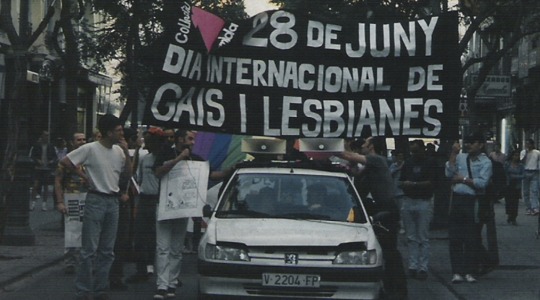
Photo: demonstration held by collective Lambda in the Valencian Country. Year unknown, probably in the late 1990s.
The political organization of the LGBTQIA+ community in the Catalan Countries took off in 1970, when the regime (at the time, Spain was a fascist dictatorship) passed a new law that controlled even more the people considered “socially dangerous”, paying special attention to same-sex attraction.
Franco’s fascist dictatorship (1939-1978), an ideology also called “NationalCatholicism”, was based on the beliefs of mandatory Catholicism and the Catholic morale (with the demonization of atheists), Spanish supremacism (and repression of the occupied nations such as Catalans, Basques and Galicians, as well as Romani people), and a strong patriarchal model in the family structure.
The State praised the ideas associated with masculinity as the political and cultural ideal, including aggressivity and the control over “his” women. Men had to marry women and become the breadwinner of the family, while women had to be submissive and dedicated only to obeying their husbands and sons.
In this context, othering those who had behaviours associated with women or homosexuals was used to delegitimize them and shun them from public space where they could be seen. The regime coupled the importance of heterosexuality with its role in producing children of the “Spanish race”, following the Catholic morale and transmitting the religion to the children.
Homophobia and transphobia were the common beliefs in society at the time, which ensured social punishment for queer people but, if the social control and self-censorship didn’t work, the State would step in with the law. The 1933 law known as vagos y maleantes (“law of idles and criminals” in Spanish) repressed the behaviours considered “antisocial”, mainly persecuting beggars, homeless and Romani people. It was altered in 1954 to include also homosexuality. This reform stated the following about homosexual people:
They had to be interned in special institutions such as work establishments or agricultural colonies, always with an absolute separation from the others.
They were forbidden from living in certain places and they always had to declare their place of residence.
They had to be monitored by guards.
They were also often arrested and beaten by the police. In 1970, a new reform of the vagos y maleantes law was even more repressive with anyone who deviated from the cisgender heterosexual norm. This triggered a response that organized the movement more than ever before, a movement that fought for the rights and freedom of the collective that at the time was called gais, lesbianes i travestis (“gays, lesbians and transvestites” in Catalan).

The first gay association in the Catalan Countries and in all the State of Spain was the Front d’Alliberament Gai de Catalunya (in Catalan, “Gay Liberation Front of Catalonia”, known by the initials FAGC), founded in 1975. The FAGC was a successful organization thanks to its activist and its ties with other leftist and pro-independence organizations in Catalonia that were also fighting against the fascist dictatorship, as well as second wave feminism.

FAGC demonstration in 1977 in Barcelona, Catalonia’s capital city.
The following year, 1976, people who had known the FAGC founded the Front d’Alliberament Homosexual del País Valencià (Homosexual Liberation Front of the Valencian Country, FAHPV). Despite its name, their actions were not limited to homosexuality: they considered that homosexuality was the representative or the public face, but that their fight was for a free sexuality for all orientations. The FAHPV was the second gay organization in the State of Spain and the first one that had an autonomous wing of lesbian fight.
The FAHPV broke up in early 1978 as a result of in-fighting, but later in the same year a new organization was formed, the Moviment per l’Alliberament Sexual del País Valencià (“Movement for the Sexual Liberation of the Valencian Country”, MAS-PV). This organization was pioneer because they used the frame of total liberation, not focused in the individual L, G, B and T letters but on the concept of sexual freedom from the cishetero norm and performativity, with little interest in the gay/lesbian identity that was often the central element at the time. This view was more similar to the queer movement that would come in the following decades with writers like Judith Butler.
Since 1986, the main organization for LGBTQIA+ rights in the Valencian Country is Lambda. And nowadays at the level of all the Catalan Countries, the strongest organization is Crida LGBTI.
Sources (in Catalan): “La lluita per l’alliberament LGTBIQ+ durant la Transició al País Valencià” in La Directa and “L’espurna del moviment valencià LGTBI” in El Temps.
#uselesslgbtfacts#història#lgbtqia+#lgbt history#lgbt#lgbtq#lgtb#gay history#gay#queer#queer history#franquismo#history#20th century history#lgbtqia#antifascism#lesbian history#pride month#país valencià#catalunya
134 notes
·
View notes
Note
Do you know of any resources about bisexuality in Catalonia in any period of time: before the 19th century, in the 19th century, in the Republican period, during the Franco dictatorship, during the transition, in any period of time at all? In Catalan, Castilian, English, or any language, really. I can't seem to find anything. There's a lot about homosexuality or lesbianism, especially during the Franco dictatorship, but not specifically about bisexuality. Like, I know about the '70s manifestations in Barcelona, but those were mostly gay men and transvestites/trans women. I know about Front d'Alliberament Gai, but that's also gays. Etc. Can you think of any landmark historical events in Catalonia involving bisexuality? Any famous bisexual writers, actors, books that mention bisexuality or have bisexual character, poems, movies or TV shows about bisexuality, particularly female bisexuality, or with bisexual characters? Any famous LGBT+ clubs in Catalonia? Any documentaries about LGBT+ history in Catalonia that include bisexuals? Any resources on how Catalans understand bisexuality, how bisexuality is seen in Catalan culture/society? Anything at all that sheds some light on the history of bisexuality in Catalonia? P.S. I understand Catalan and Spanish but writing in English comes easier to me, hence why I wrote this in English.
Hello!
It's true that there is a lot of important lesbian and gay literature and referents, but there's not many for bisexuality.
There are many documentaries and books about the queer life and queer movement in Catalonia, but I've never seen any mention bisexuality as a separate orientation since that understanding is quite new. The documentaries who talk to people who fought in the queer movement of the 70s-80s, they view it as "same sex attraction", the focus on attraction, not identity understood with the current/American categories.
For this reason, we can't really talk about bisexual-only organisations or spaces (they were mixed in gay and lesbian spaces; especially historically upper class bi men were together with upper class gay men, and in the late 20th century lesbian and bisexual women spaces were also shared related to the feminist movement, which was the first to talk about women's sexuality).
But I can talk about individual referents.
The most obvious one that quickly comes to mind is the novel Bearn o la sala de les nines (1956) by Llorenç Villalonga. It's a classic (similar to "Il Gattopardo", about the fall of the aristocracy), and a mandatory book to read in high school Catalan literature class. The plot doesn't explicitly show bisexuality, but under all the book there are lots of metaphors and hidden ways of saying that one of the main characters was bisexual, and it's quite important to understand the book. A lot of the book is symbolic, for example it's very important that a character keeps a room full of dolls (the "sala de les nines" on the title) hidden and doesn't let people in: that's a metaphor for his bisexuality. Many things in the book refer to the "ambiguity" of that character, also in his gender expression.
Another character is Víctor (male character, one of the 2 main characters) in La festa dels morts (1973) by Antònia Vicens. I haven't personally read this one, but I know it's explicit and part of the main plot (the book is about a girl who reunites with her ex-lover -this Víctor- but now Víctor is in love with a man).
Lluís Llach, though he himself is gay, also has bisexual men as main characters in his novels Memòria d’uns ulls pintats (2012) and Les dones de la Principal (2014).
If you're interested in contemporary literature, you could check out the festival Qlit (Festival de Literatura Queer) organised by the AELC (Associació d'Escriptors en Llengua Catalana, a very important association of Catalan writers).
There's also an anthology called Amors sense casa. Poesia LGBTQ catalana (2018) that brings together queer Catalan poetry, but I haven't read it so I don't know how much B there is.
A teenage drama TV show called Merlí, which was very popular in Catalonia some years ago, also features a main character (Pol) who is a bisexual boy.
Famous (real) Catalan bi people are Salvador Dalí and Lluís Gavaldà (singer of the band Els Pets, one of the most important Catalan bands since the late 1990s).
However, I cannot think of a single reference to a bisexual woman.
Lastly, I want to say that I have asked a friend who is graduating this year in Gender Studies in a university here in Catalonia. She confirmed the same I thought and also adds that she had a seminar where it was mentioned that there were LGBTQ groups within Catalonia's anarchism before and during the Civil War, but she doesn't have a reference about it and I haven't found anything online. She has sent your question to the WhatsApp group chat with her classmates, so if they say any more information I will add it to this post. And you can check if any of the followers of this blog add something in the comments.
I'm sorry I couldn't be more useful, I hope you can find what you're looking for!
56 notes
·
View notes